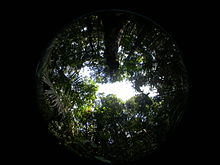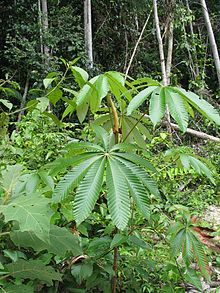Talk:Patch dynamics
| This article is rated Start-class on Wikipedia's content assessment scale. It is of interest to the following WikiProjects: | |||||||||||
| |||||||||||
External links do not work.
| This article was the subject of an educational assignment. |
We are Tropical Ecology Students from the University of Florida doing a project on Gap Dynamics. Feel free to provide feedback and comments.
Gap Dynamics

Gap dynamics refers to the pattern of plant growth that occurs following the creation of a forest gap, a local area of natural disturbance that results in an opening in the canopy of a forest. Gap dynamics are a typical characteristic of both temperate and tropical forests and have a wide variety of causes and effects on forest life.
Gaps are the result of natural disturbances in forests, ranging from a large branch breaking off and dropping from a tree, to a tree dying then falling over, bringing its roots to the surface of the ground, to landslides bringing down large groups of trees. Because of the range of causes, gaps therefore have a wide range of sizes, including small and large gaps. Regardless of size, gaps allow an increase in light as well as changes in moisture and wind, leading to differences in microclimate conditions compared to those from below the closed canopy, which are generally cooler and more shaded.
For gap dynamics to occur in naturally disturbed areas, either primary or secondary succession must occur. Ecological secondary succession is much more common and pertains to the process of vegetation replacement after a natural disturbance. Secondary succession results in second-growth or secondary forest, which currently covers more of the tropics than old-growth forest.
Since gaps let in more light and create diverse microclimates, they provide the ideal location and conditions for rapid plant reproduction and growth. In fact, most plant species in the tropics are dependent, at least in part, on gaps to complete their life cycles.
Disturbances
edit
Gap dynamics are the result of disturbances within an ecosystem. There are both large scale and small scale disturbances, and both are influenced by duration and frequency. These all affect the resulting impact and regeneration patterns of the ecosystem.
The most common type of disturbance within a tropical ecosystem is fire. Historical evidence of fire can be studied by examining soil charcoal patterns within different elevations. Since the Holocene era, there is proof of multiple regional forest fires in tropical areas such as Costa Rica, caused by both humans and natural occurrences. Human set fires are a current concern for conservation biologists, due to their unnatural progression toward gap dynamics. Fires set in tropical rain forests can lead to savanna development and an accumulation of peat. Peat, or the remains of organic matter in acidic soil, can be highly combustible and cause extensive and dangerous fires when ignited. Since most nutrients in a tropical ecosystem are contained in the biomass of plants, fire is an important component of recycling these nutrients and therefore regenerating an ecosystem.
Another large scale disturbance is flooding. Flooding can erode coastal areas and cause damage to current vegetation. However, it also redistributes sediments and nutrients, which can help fertilize soil. Weather is the cause of many large scale disturbances, including hurricanes and monsoons. An example of a small scale disturbance is a tree falling. This can cause soil movement, which redistributes any nutrients or organisms that were attached to the tree. The tree falling also opens up the canopy for light entrance, which can support the growth of other trees and plants.
After a disturbance, there are several ways in which regeneration can occur. One way, termed the advance regeneration pathway, is when the primary understory already contains seedlings and saplings. This method is most common in the Neotropics when faced when small scale disturbances. The next pathway is from tree remains, or any growth from bases or roots, and is common in small disturbance gaps. The third route is referred to as the soil seed bank, and is the result of germination of seeds already found in the soil. The final regeneration pathway is the arrival of new seeds via animal dispersal or wind movement. The most critical components of the regeneration are seed distribution, germination, and survival. [1]
Primary Succession
editSuccession is the slow rebuilding of forest gaps from natural or human disturbances. When major geological changes such as volcano eruptions or landslides occur, the current vegetation and soil may erode away leaving only rock. Primary succession occurs when pioneer species such as lichens colonize rock. As the lichens and mosses decompose, a soil substrate forms called peat. The peat, over time, will create a terrestrial ecosystem. From there on herbaceous, non-woody plants will develop and trees will follow. Major holes or gaps in the forest ecosystem will take hundreds of years to regenerate from a rock base.[2]
Secondary Succession
edit
Secondary succession occurs where a disturbance has taken place but soil remains and is able to support plant growth. It does not take nearly as long for plant regeneration to occur because of the soil substrate already present. Secondary succession is much more common than primary succession in the tropics.
Ecological secondary succession occurs in four distinct phases: First, rapid colonization of cleared land by species such as herbs, shrubs, and climbers as well as seedlings from pioneer tree species occurs and this can last up to three years. After that, short lived but fast growing shade intolerant species form a canopy over 10 to 30 years. Non-pioneer heliophilic (sun-loving) tree species then add to the biomass and species richness as well as shade tolerant species and this can last 75 to 150 years. Finally, shade-tolerant species regain full canopy stature indefinitely until another major disturbance occurs.[3]
Secondary succession in the tropics begins with pioneer species, which are rapidly growing and include vines and shrubs. Once these species are established, large heliophilic species will develop such as heliconias. Cecropias are also a major pioneering tree in the tropics and they are adapted to grow well where forest gaps are giving way to sunlight. Shade-tolerant species that have remained low in the forest develop and become much taller. These successional phases do not have definite order or structure and because of the very high biodiversity in the tropics, there is a lot of competition for resources such as soil nutrients and sunlight.
Examples of Tree Dynamics
editDue to the fact that horizontal and vertical heterogeneity of a forest is significantly increased by gaps, gaps become an obvious consideration in explaining high biodiversity. It has been proven that gaps create suitable conditions for rapid growth and reproduction. For example, non-shade tolerant plant species and many shade-tolerant plant species respond to gaps with an increase in growth, and at least a few species are dependent on gaps to succeed in their respected environments (Brokaw 1985; Hubbell and Foster 1986b; Murray 1988; Clark and Clark 1992). Gaps create a diverse microclimates, affecting light, moisture, and wind conditions (Brokaw 1985). A study conducted on Barro Colorado Island in Panama showed that gaps had greater seedling establishment and higher sapling densities than control areas.
Species richness was higher in gaps than in control areas, and there was more diversity in species composition among gaps. However, this study also found that there was a low recruitment rate per gap, which explains why gaps differed in species composition. With 2% to 3% for pioneer species and 3% to 6% for shade-tolerant and intermediate species. Suggesting that most species could not take advantage of gaps because they couldn’t get to them through seed dispersal. With that said, the Janzen-Connell effect plays a major role in the tree species’ relationship with gaps. The Janzen-Connell density dependent mortality model states that most trees die as seed or seedlings. In addition, host-specific predators or pathogens are predicted to be greatest where density is greatest, which is underneath parent tree. This corroborates with the major causes of gaps, which are the falling of trees due to mortality caused by termites or epiphyte growth. The Janzen-Connell model also states that balance between dispersal distance and mortality should cause highest recruitment to be at a certain distance away from the parent. Therefore if these gaps are being created by the parents, the seedlings recruit away from the gap, resulting in increasing survival rates as the distance from the parent increases. This explains the low recruitment rate per gap found in the experiment conducted in Barro Colorado Island.[4]
In corroboration, a study conducted in La Selva in Costa Rica calculated the crown illumination index for nine tree species ranging from gap specialists to emergent canopy species. Crown illumination values ranged from 1, which indicated low light, and 6, which indicated that the tree crown was completely exposed . After using a mathematical model to calculate the changes in tree diameter and changes in crown illumination with age. This model helped estimate life expectancy, time of passage to various sizes, and age patterns of mortality. The results showed what most gap dynamics studies show, pioneer species thrived in high light environments and non-pioneer species showed high mortality when young but the rate of mortality decreased as they aged. However, once trees were very large survivorship then decreased.[5]
References
edit- ^ Kricher, John (2011). Tropical ecology. Princeton, New Jersey: Princeton University Press. pp. 188–226.
- ^ Brokaw, N.V.L. (1985). The Ecology of Natural Disturbance and Patch Dynamics. San Diego, California: Academic Press. pp. 53–69.
- ^ "Tree Demography and Gap Dynamics in a Tropical Rain Forest". Ecology. 70 (3): 555–558. 1989.
{{cite journal}}: Unknown parameter|coauthors=ignored (|author=suggested) (help); Unknown parameter|month=ignored (help) - ^ Hubbell, S. P. and R. B. Foster (1986). Plant Ecology. Oxford, UK: Blackwell. pp. 77–95.
- ^ Clark, JS (1992). Ecosystem Rehabilitation: Preamble to Sustained Development. SPB Academic Publishing. pp. 165–186.
Major Edits for Class
editHi, we are part of an advanced plant ecology class and we are planning to complete edits on the patch dynamics page.Ecopatch (talk) 19:29, 8 December 2015 (UTC)
- Hey! I'm a part of this class as well, just a heads up to others that we will both be editing. If there are problems, let us know. 2Rockz (talk) 19:29, 8 December 2015 (UTC)
- Here are the proposed edits for the page
- Line 1 edits will include restructuring of the first sentence and clarification of major concepts.Ecopatch (talk) 20:28, 8 December 2015 (UTC)
- Line 1 edits will remove the ie explanation in the parentheses and we will create a new sentence with the contents.Ecopatch (talk) 20:28, 8 December 2015 (UTC)
- And so am I part of this; hope the day finds you likewise.DrTeh (talk) 02:05, 9 December 2015 (UTC)
To any interested in viewing or approving our proposed edits, they updated page, as we work on it, will be a part of my sandbox. We simply ask that, as this is a class project, comments and ideas be shared with us instead of added to the edits. Thank you!! 2Rockz (talk) 21:19, 10 December 2015 (UTC)
Wiki Education assignment: Plant Ecology Winter 2023
editThis article was the subject of a Wiki Education Foundation-supported course assignment, between 16 January 2023 and 10 April 2023. Further details are available on the course page. Student editor(s): Magnolia champaca (article contribs).
— Assignment last updated by Magnolia champaca (talk) 18:26, 6 February 2023 (UTC)
